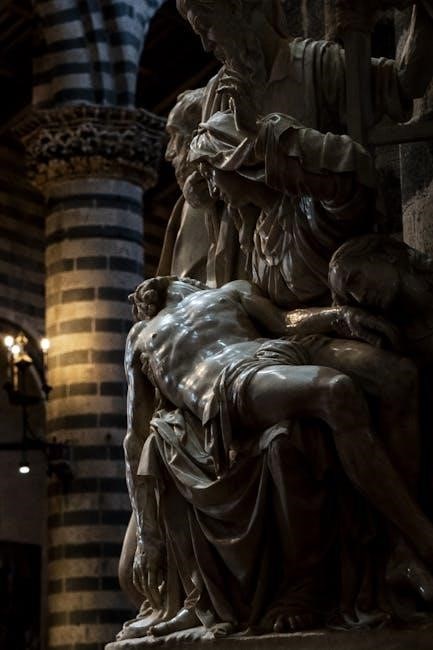The physical death of Jesus Christ is a pivotal event analyzed through medical, historical, and theological lenses. This discussion explores the crucifixion’s brutality, its physiological effects, and the historical context, aiming to provide a comprehensive understanding of this significant event.

Historical Context of Jesus’ Death
Jesus’ death occurred within the complex interplay of Jewish and Roman legal systems. Following Jewish trials and Roman sentencing by Pontius Pilate, Jesus was flogged and condemned to crucifixion, a common Roman execution method, marking the culmination of political and religious tensions.
2.1. Jewish and Roman Trials
Jesus’ death was preceded by a series of legal proceedings, involving both Jewish and Roman authorities. The Jewish trial, conducted by the Sanhedrin, focused on charges of blasphemy, as Jesus was accused of claiming divine authority. This led to a sentence of death under Jewish law. However, since the Romans held exclusive authority to execute criminals, the case was referred to Pontius Pilate, the Roman prefect. The Roman trial accused Jesus of treason, specifically for declaring himself “King of the Jews,” a threat to Roman rule. Despite Pilate’s hesitation, influenced by political pressure and the demands of the crowd, Jesus was sentenced to crucifixion. These trials highlight the intersection of religious and political motivations that led to his execution. The legal processes, though flawed, set the stage for the events that followed, ultimately resulting in one of history’s most significant deaths.
2.2. The Crucifixion Practice in Ancient Rome
Crucifixion was a brutal execution method employed by the Romans to instill fear and maintain control over subjugated populations. It was typically reserved for slaves, rebels, and non-Roman citizens. The process involved nailing or tying the victim to a wooden cross, often in a public setting to maximize visibility and deterrence. The cross consisted of two beams: the stipes, a vertical post, and the patibulum, a horizontal crossbar. Victims were often scourged beforehand, leading to severe blood loss and physical weakening. Once on the cross, the victim’s wrists and feet were nailed, causing immense pain and complicating breathing. Death resulted from a combination of blood loss, hypovolemic shock, and asphyxiation, as the position made it difficult to breathe. Crucifixion was designed to prolong suffering, with victims sometimes enduring days before succumbing. This practice was central to Jesus’ execution, as described in historical accounts, and it remains a critical element in understanding the physical and emotional toll of his death.
2.3. The Role of Scourging in Roman Execution
Scourging was a brutal preliminary punishment in Roman executions, designed to weaken the victim and inflict severe pain; The Romans used a flagellum, a whip with leather thongs often embedded with metal or bone fragments, to lacerate the skin. This practice was intended to humiliate and incapacitate the condemned, making the subsequent crucifixion even more agonizing; In Jesus’ case, the scourging caused deep, stripelike lacerations and significant blood loss, which likely led to hypovolemic shock. His weakened state is evident from the fact that he could not carry the crossbar (patibulum) to Golgotha. The physical toll of scourging, including muscle damage and internal bleeding, exacerbated the suffering during crucifixion. This practice was a key component of Roman execution, ensuring the victim’s torment began long before the crucifixion itself. The severity of the scourging underscores the extreme physical and emotional suffering endured by Jesus, aligning with historical and medical accounts of the crucifixion process.

Medical Analysis of Jesus’ Death
Medical analysis of Jesus’ death focuses on the physiological effects of crucifixion. The process led to hypovolemic shock from blood loss, respiratory impairment, and eventual asphyxiation. The spear wound to his side confirmed his death, as modern medical studies conclude he was lifeless when removed from the cross.

3.1. The Effects of Scourging on the Human Body
Scourging, a brutal form of punishment, caused deep stripelike lacerations and significant blood loss, leading to hypovolemic shock. This condition arises from inadequate blood volume, impairing the body’s ability to maintain blood pressure and supply oxygen to vital organs. The physical trauma weakened Jesus, as evidenced by His inability to carry the crossbar to Golgotha. The severe blood loss and dehydration would have caused extreme exhaustion, dizziness, and disorientation. The psychological toll of such pain and humiliation further exacerbated His physical state. Medical studies suggest that the scourging was a critical factor in setting the stage for the physiological events that led to His death. The combination of blood loss, shock, and subsequent crucifixion created a lethal scenario, highlighting the devastating effects of Roman scourging on the human body.
3.2. The Physiology of Crucifixion
Crucifixion inflicted severe physiological distress, primarily through its impact on respiration. With the arms stretched overhead and nailed to the crossbar, the chest was pulled upward, making it difficult to breathe. Each attempt to exhale required the victim to push down on their nailed feet, causing excruciating pain. This mechanism led to shallow breathing and inadequate oxygen intake, progressively causing asphyxiation. The blood loss from the scourging and nail wounds further reduced oxygen delivery to tissues, accelerating hypoxia. Dehydration and metabolic acidosis from prolonged exposure exacerbated the suffering. The combination of blood loss, hypovolemic shock, and respiratory failure created a lethal environment, ultimately leading to cardiac arrest. Medical analyses confirm that crucifixion was a torturous and fatal method of execution, designed to prolong suffering while ensuring death through multiple physiological failures. The specific positioning and injuries Jesus endured align with historical and medical descriptions of crucifixion’s devastating effects on the human body.
3.3. Hypovolemic Shock and Blood Loss
Hypovolemic shock, a condition caused by severe blood loss, played a critical role in Jesus’ death. The scourging he endured inflicted deep lacerations, leading to significant blood loss, which likely initiated the onset of shock. This condition impairs the body’s ability to maintain blood pressure and supply oxygen to vital organs. Jesus’ weakened state, as evidenced by his inability to carry the cross, aligns with symptoms of hypovolemic shock, including dizziness, fainting, and reduced consciousness. The extensive blood loss from the scourging and crucifixion wounds further exacerbated the shock, compromising his cardiovascular system. Medical experts agree that the combination of blood loss and the physical strain of crucifixion created a lethal environment, accelerating organ failure and ultimately leading to death. This physiological response highlights the extreme suffering and medical inevitability of death under such conditions.
3.4. Asphyxiation as a Cause of Death
Asphyxiation is widely regarded as a primary cause of death in crucifixion cases, including that of Jesus Christ. The crucifixion process severely impaired Jesus’ ability to breathe, as the position of the body on the cross made it difficult to expand the chest and diaphragm. The upward gaze required to breathe exacerbated the strain on the respiratory muscles, leading to rapid fatigue and insufficient oxygen intake. The deep wounds from the scourging and the nails in his wrists and feet further contributed to his distress, as pain and blood loss heightened the body’s metabolic demand for oxygen. The physiological effects of crucifixion, such as hypercapnia (elevated carbon dioxide levels) and acidosis, would have intensified the suffocation. Eventually, the exhaustion of respiratory muscles led to asphyxiation, marking the end of Jesus’ life. This medical explanation aligns with historical accounts and underscores the brutal efficiency of crucifixion as a method of execution. The combination of blood loss, shock, and respiratory failure created an irreversible pathophysiological state, ensuring death.
3.5. The Spear Wound and Its Implications
The spear wound inflicted on Jesus after his crucifixion holds significant medical and theological implications. According to historical accounts, a Roman soldier thrust a spear into Jesus’ side, resulting in the flow of blood and water. This event is medically consistent with the presence of a pericardial effusion, where fluid accumulates in the sac surrounding the heart due to severe trauma and hypovolemic shock. The blood loss from the spear wound further exacerbated Jesus’ already critical condition, accelerating his death. Medically, this injury would have caused fatal cardiac tamponade, leading to cardiac arrest. Theologically, the spear wound is often interpreted as a fulfillment of prophecy and a symbol of divine sacrifice, emphasizing the completeness of Jesus’ death. This act also underscores the brutality of crucifixion, ensuring that death was irreversible. The spear wound, therefore, serves as both a medical confirmation of death and a profound theological symbol, highlighting the severity of Jesus’ suffering and the finality of his sacrifice.

Theological Significance of Jesus’ Death
Jesus’ death is central to Christian theology, symbolizing divine love and redemption. It represents the ultimate sacrifice for humanity’s sins, achieving reconciliation with God and fulfilling Old Testament prophecies. This act embodies God’s justice and mercy, establishing a New Covenant.
4.1. The Atonement Theory
The Atonement Theory is a cornerstone of Christian theology, explaining how Jesus’ death reconciles humanity with God. This doctrine posits that Jesus’ sacrifice on the cross was a redemptive act, paying the debt for humanity’s sins. By voluntarily enduring crucifixion, Jesus fulfilled the demands of divine justice, offering forgiveness and restoring relationship with God. The New Testament emphasizes this in Romans 5:8, where Paul writes, “But God proves His love for us in this: While we were still sinners, Christ died for us.” This sacrifice is seen as a substitutionary atonement, where Jesus bore the punishment for sin on behalf of humanity. The Atonement Theory underscores the depth of God’s love and the gravity of human sin, while also highlighting the transformative power of grace. It is through this act that believers are justified and sanctified, receiving eternal life. The Atonement Theory remains central to Christian faith, bridging the gap between God’s holiness and humanity’s imperfection through Jesus’ ultimate sacrifice.
4.2. Sacrificial Death in Christian Doctrine
Sacrificial death in Christian doctrine is a central tenet, rooted in the belief that Jesus’ physical death on the cross was an act of divine sacrifice to atone for humanity’s sins. This concept is deeply tied to the idea of substitutionary atonement, where Jesus willingly took upon himself the punishment deserved by humanity, satisfying God’s justice and enabling reconciliation. The New Testament emphasizes this in John 3:16, where Jesus is described as God’s gift to humanity, offering eternal life through his sacrifice. Christian doctrine further teaches that Jesus’ death was a once-for-all sacrifice, surpassing the repeated offerings of the Old Testament. By shedding his blood, Jesus provided a perfect and sufficient atonement for sin, demonstrating both God’s love and His holiness. This sacrificial act is seen as the ultimate expression of divine mercy, allowing believers to be justified and reconciled to God. The sacrificial death of Jesus is thus celebrated in Christian worship and theology as the foundation of salvation and the means by which humanity is restored to a right relationship with God.
4.3. The Concept of Redemption Through Death
The concept of redemption through Jesus’ death is a cornerstone of Christian theology, emphasizing deliverance from sin and its consequences through his sacrificial act. Redemption is portrayed as the liberation of humanity from spiritual bondage, achieved by Jesus’ willingness to endure physical death on the cross. This idea is rooted in the New Testament, where Paul writes in Romans 3:24-25 that believers are justified freely through the redemption that came by Christ Jesus. The death of Jesus is seen as the price paid to ransom humanity from sin’s dominion, highlighting divine love and justice. Redemption is not merely a legal transaction but a transformative experience, restoring believers’ relationship with God. This concept is central to Christian worship and doctrine, celebrated in hymns and liturgy as a testament to God’s grace. Through his death, Jesus provided the means for humanity’s salvation, offering eternal life and reconciliation with the divine. The redemptive power of Christ’s death is thus viewed as the ultimate act of divine mercy, shaping Christian identity and hope.

Modern Medical Interpretations
Modern medical analysis suggests that Jesus’ death resulted from hypovolemic shock and asphyxiation, compounded by severe blood loss from scourging and crucifixion. The spear wound to his side likely caused fatal internal injuries, confirming his death before removal from the cross.

5.1. Forensic Analysis of Crucifixion
Forensic analysis of crucifixion reveals the extreme physical suffering endured by Jesus. The process typically began with scourging, which caused deep lacerations and significant blood loss. This led to hypovolemic shock, a condition characterized by inadequate blood circulation. The Roman method of crucifixion involved nailing the victim’s wrists and feet to a cross, causing intense pain and impairing respiratory function. As the victim tired, breathing became increasingly difficult, leading to asphyxiation. In Jesus’ case, the Roman soldier’s spear wound to his side likely pierced vital organs, including the heart or lungs, hastening his death. Modern forensic studies confirm that the combination of blood loss, hypovolemic shock, and asphyxiation would have been fatal. The medical evidence aligns with historical accounts, providing a scientific basis for understanding the physical death of Jesus Christ.
5.2. Expert Opinions on the Cause of Death
Medical experts and historians have extensively analyzed the cause of Jesus’ death, with a consensus emerging on the primary factors. Dr. William D. Edwards, a prominent medical examiner, highlights that the combination of severe blood loss from scourging and the crucifixion itself led to hypovolemic shock, a critical condition characterized by insufficient blood volume to sustain vital organs. Additionally, the crucifixion position severely restricted breathing, leading to asphyxiation as the victim’s strength waned. The spear wound to Jesus’ side, as documented in the New Testament, likely punctured vital organs such as the heart or lungs, accelerating his death. Other experts, such as Dr. Gary Habermas, concur that the cumulative effects of these injuries made survival impossible. Modern forensic analysis supports these conclusions, confirming that Jesus’ death was the result of a combination of hypovolemic shock, asphyxiation, and traumatic injury from the spear. These expert opinions align with historical and medical evidence, providing a comprehensive understanding of the physical circumstances surrounding Jesus’ death.
5.3. The Role of Modern Science in Understanding Jesus’ Death
Modern science has significantly enhanced our understanding of Jesus’ death by applying advanced forensic and medical techniques to historical accounts. Forensic pathologists have analyzed the effects of scourging and crucifixion, revealing the severe physical trauma Jesus endured. Studies published in medical journals, such as those by Dr. William D. Edwards and Dr. Gary Habermas, detail how the lacerations from scourging led to substantial blood loss, likely inducing hypovolemic shock. Additionally, modern insights into the physiology of crucifixion explain how the position on the cross impeded breathing, leading to asphyxiation. The spear wound, examined through trauma analysis, is identified as a fatal injury, likely piercing vital organs. These scientific investigations corroborate biblical accounts, providing a medically accurate depiction of Jesus’ death. By bridging historical narratives with contemporary medical knowledge, modern science offers a detailed and evidence-based understanding of the physical suffering and cause of death, enriching both theological and historical perspectives on this event.

Scholarly Debates and Controversies
Scholars debate the exact cause of Jesus’ death, with theories ranging from hypovolemic shock to asphyxiation. Controversies also surround the historical accuracy of biblical accounts and the theological implications of his death, sparking ongoing discussions among historians, theologians, and medical experts.
6.1. Speculation About the Exact Cause of Death
There is ongoing debate among scholars and medical experts about the exact cause of Jesus’ death. Some attribute it to hypovolemic shock from severe blood loss due to scourging, while others emphasize asphyxiation as the primary cause. Medical analyses suggest that the combination of flogging, crucifixion, and the spear wound created a lethal scenario. However, theories vary, with some proposing cardiac arrest or exhaustion as contributing factors. The physiological effects of crucifixion, such as respiratory distress and circulatory failure, further complicate the determination of a single cause. Despite these speculations, the consensus among many experts is that Jesus’ death was the result of multiple factors stemming from the brutality of crucifixion. This debate highlights the complexity of reconstructing historical events through medical and historical lenses, underscoring the need for interdisciplinary approaches to understand the circumstances surrounding his death.
6.2. Theological Debates on the Purpose of Death
The theological significance of Jesus’ death has sparked extensive debates, particularly regarding its purpose. Central to Christian doctrine is the belief that Jesus’ death was a sacrificial atonement for humanity’s sins, reconciling humans with God. This is rooted in the New Testament, where Paul emphasizes that Christ died for us while we were still sinners, demonstrating divine love and justice. The atonement theory posits that Jesus’ death satisfied God’s justice, thereby enabling forgiveness of sins. However, various interpretations exist within this framework, such as the satisfaction theory, which views Jesus’ death as a payment to God, and the moral influence theory, which highlights the exemplary nature of Jesus’ sacrifice to inspire moral transformation. Despite these debates, the unifying theme across Christian theology is that Jesus’ death was a purposeful act of redemption, intended to restore humanity’s relationship with God. Theological discussions continue to explore the depth and implications of this sacrificial death, underscoring its central role in Christian faith and doctrine.
6.3. Historical Accuracy in Biblical Accounts
The historical accuracy of biblical accounts regarding Jesus’ death has been a subject of scholarly debate. While the New Testament provides detailed descriptions of the events leading to and surrounding Jesus’ crucifixion, historians and theologians often examine these narratives for corroboration with external sources. Jewish and Roman records from the 1st century, such as those by Tacitus and Flavius Josephus, provide indirect references to Jesus and early Christianity, lending credibility to the historical context of the crucifixion. However, discrepancies in the biblical accounts, such as the role of Pontius Pilate and the specifics of Jewish and Roman legal proceedings, have sparked discussion. Some scholars argue that the biblical narratives are rooted in historical events but may have been influenced by theological motivations. Others contend that the accounts are reliable historical records, with internal consistency and coherence. Despite these debates, the crucifixion of Jesus is widely accepted as a historical event, with the core details aligning with the practices of ancient Rome. The integration of historical and theological perspectives remains crucial for understanding the death of Jesus Christ.
